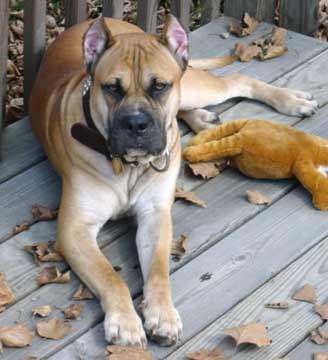- Alano Español
Infobox Dogbreed

name = Alano Español
altname = Spanish Alano
Spanish Bulldog
nickname = Alano
country = flagcountry|Spain
notrecognized = no standards availableAlano Español or Spanish Bulldog is a Spanish breed of
dog that derives its name from theMolosser Alaunt . The breed received recognition from the Spanish Ministry of Agriculture and the RSCE in 2004.Description
The Alano Español is a powerful dog, suitable for running, herding cattle and holding large animals. This dog has a well proportioned body structure and a deep chest, strong shoulders and withers. The back legs are slightly shorter than the front legs, which are straight when viewed from the front or the side. The muscles in the hindquarters are well developed and the hind legs show very well defined angulation . The tapering tail is carried in a low arc. The stomach retracts inward in order to give him a more athletic appearance than other heavier breeds. The neck is strong, powerful and wide. The Alano has extremely powerful jaws with a very strong and firm reverse-scissors bite. Coat colors include Brindle, Fawn, Reds, Black and Brindle and Sable Wolf.
Weight 20-40kg
History
The Spanish Alano today is a legacy od the Alan tribe which entered the Iberian Peninsula with the Vandal hordes during the early part of the 5th Century. The Alani were one of the Sarmatian peoples which inhabited the plains along the River Don to the northeast of the Sea of Azov in modern-day Russia. Formidable horsemen and skilled bowmen, these warring nomads were also famous for their dogs.
The Alani were a scourge of the Roman Empire and of the Caucaus during the 1st and 2nd Centuries AD. Their numbers and skill in battle meant they were rarely challenged, more so since they were known to sack and lay to waste great kingdoms in the face of resistance. Their supremacy was challenged in the latter part of the 4th Century by the Huns. Some of the Alani settled in Southern France and invaded England, the majority went with the Vandals to North Africa near Carthage. The formal dissolution of the Alani came after a battle with Visigoths in which their King, Attaces, died in 418 AD. The Alan Crown was then unified with the Vandal Crown under Gunderic.
The Spanish Alano derives from those dogs maintained by the Alani. 'Alanos' were hunters and guardians. Their courage, prowess, agility, strength and stamina were celebrated. A detailed description of the 'Alano' is in Edmond de Langley's 15th Century text, "Mayster of Game", as well as in Chaucer's "The Knight's Tale". A black-masked 'leonado' Alano is featured holding a wild boar by the ear in a painting by A. Hondius of 1585. There are also many accounts of the roles of such dogs during the Spanish Conquests of the Americas, such as Becerrillo and Leoncillo. Alanos were used in the ‘Corridas’ until 1883. The popularity of the dogs waned at the turn of the 20th Century when other breeds came into fashion and pastoral methods and livestock management changed. The breed was considered extinct in 1963.
Recuperation
A band of veterinary medicine students and die-hard Alano enthusiasts intent on a recuperation of this breed, set to work in the late 1970s and early 80's. After scouring Western and Northern Spain conducting house-to-house enquiries with old photographs, their labours were rewarded.Few examples remained in Estremadura or Castille, but a number were found in Las Encartaciones, Cantabria, doing tasks which they had been exercising for almost two millennia, hunting wild boar and herding Monchina, a semi-wild breed of Iberian Red cattle.
External links
* [http://csac.bravehost.com/ Canadian Spanish Alano Club]
* [http://spanish-alano.com/index.html Spanish Alano]
Wikimedia Foundation. 2010.
